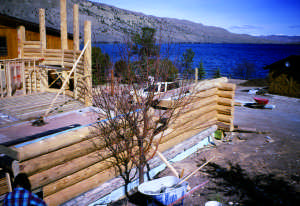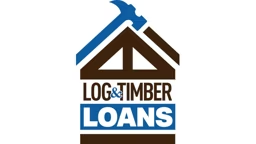A log home construction authority shares the ins and outs to establish a budget that will allow you to build the log home of your dreams.
By Joseph L. Walsh
As you prepare to build the log home of your dreams, you will need to establish a budget for the project. An honest, comprehensive budget  from Day One should change very little, if you make the conscious decision to stick to it. With the exception of your expensive taste, there are only a few phases of the project that have the ability to surprise you: impact fees; excavation; well; septic; utilities; and environmental issues (wetlands, runoff and such). If you're fortunate to have these items work out in your favor, then all there is to be concerned about is you.
from Day One should change very little, if you make the conscious decision to stick to it. With the exception of your expensive taste, there are only a few phases of the project that have the ability to surprise you: impact fees; excavation; well; septic; utilities; and environmental issues (wetlands, runoff and such). If you're fortunate to have these items work out in your favor, then all there is to be concerned about is you. The key to any budget is to find your comfort level. For instance, if you are in your mid-20s with no children and a rapidly increasing income, then spending a bit beyond your means may not be a terrible thing. Of course, if you are on a fixed income and in your 60s, it will make more sense to build a log home that is well within your means. You must find your own comfort level and then keep it in sight throughout the entire project. There are some very simple methods to establishing a proper budget, but first you'll need to know how much you can afford. There are many formulas, graphs and theories on planning your
mortgage qualifications, but the basic ones are still the best. It is widely accepted in the financial industry that someone with minor debt will qualify for 2 1/2 to 3 times their gross household income in today's world of relaxed interest rates. However, you are the only one who can decide if this is a comfortable level. Log homes have some interesting advantages in regards to their worth. For instance, with a conventional home, the material value of the structure is quite low; your appraised value rests on little more than what the next guy is willing to pay for the home. Log homes, however, have great value in their components and thereby increasing their worth. The challenge, however, is that regardless of home style, you still need to establish comps (comparable homes in a designated geographic area) for a lender to loan you money. This is where a highly qualified appraiser, ideally with an understanding of log home construction, is invaluable.
Dollars and Sense
Once you know the total amount of money you are able to borrow, you then can start to establish a budget. This actually can be a very simple process. You'll first want to sit down with a few companies that you feel represent what you desire in your log home, but you won't need to go through a detailed quote process to find out how much home you can get for the dollar figure you can afford. The log home representative will be able to give a fairly targeted square-footage figure to build a log home in your area; they also will be familiar with local land prices. You'll want to know figures for three different scenarios: 100-percent turn key (you move into a completed home), 100-percent customer labor (customer does the work ) and average actual square foot price (customer and hired labor combined). Many people wish to build their own home, and many more wish to have the home built 100 percent for them. In the end, most people will end up somewhere in the middle. A turnkey figure typically is everything excluding the land. You'll likely be planning your project around this figure. If you hire someone to build the home, you will be prepared by planning things around this figure. Any company should be able to get you very close to the end figure, but be aware that this figure will vary greatly in different areas of the country due to radically different labor costs. Regardless of whether you choose a company that supplies strictly log and timber packages or a company that sells complete packages, your finished building cost will be very close between either of them if they are built in the same geographic region using similar materials. If you are considering a company that supplies the raw logs and timbers only, you will need to get a detailed list of materials needed to complete the home in order to figure your actual finish costs. A knowledgeable private lumberyard or a general contractor can complete this task for you.
Windows, Doors and More
Windows and doors are two of the most undervalued items when a customer is working to establish a budget. It is of paramount importance that you figure a proper value for these components. As with everything else in life, the price will be directly proportional to the quality of the product. If your budget gets snug and you cut corners on the windows and doors, it will be a big mistake that you will certainly pay for later in terms of energy efficiency. If the log home supplier does not provide the windows and doors, then selections are as simple as a click of the mouse in your own home. Using an Internet search engine, you can type in the window and door company's name and find out everything you need to know about the materials, warranties, options, company history and sometimes feedback from actual customers (both good and bad). Then you will need to go to the lumberyard to get the actual costs. Never use a ballpark figure. The home budget should read like a book from start to finish. It should include all the major figures, but also the soft costs along the way. Start your budget with land research and purchase issues: surveying, biologist fees, engineering, variance fees (if needed), bank fees, closing costs and purchase price. Next will be the costs involved with preparing the land for the home: tree removal, stump clearing, brush removal, excavation for foundation and septic and driveway. The next items will be on the installation end: utilities, foundation, well, septic, waterproofing for foundation, insulation, backfill and drain tiles. At this time, we need to start figuring the actual costs of the home. You will first need to figure out how much material is in the package. Some packages are very complete, and you will need only to figure items such as mechanical trades, floor coverings, cabinets and labor. Other options will require a bit more figuring, which is ok, but you have to make sure that nothing is missed to ensure an accurate budget. You will need to start applying labor figures now for dry-in erection and finish carpentry. This will be a good portion of the labor within these two figures.

Establish a budget and stick with it to ensure a smooth log home construction process.
As you start to shop for your build team, you should acquire a written quote from three reputable contractors. Your
log home representative should be able to tell you what contractors you need to shop for. Ask your family and friends for suggestions on contractors; this is the best way to know what to expect from a contractor. One word of caution: Each home, site, electrical system or plumbing system is completely different, so never use figures from someone else's home for they will seldom be accurate. This step can take a while, so always allow yourself an ample period of time. There are some soft costs that should definitely be remembered. They usually are paid outside of the construction mortgage itself. The typical soft cost items include things such as dumpsters, portable restrooms, temporary utilities and insurance. Much of this budgeting is done the same way you would figure the grocery budget. You know what you need; but once you know what you can afford, you can see if the two are within sight of each other. Much like the grocery budget, prime rib is not on the menu every day for most people. It will be up to you to decide just when you get the steak and when you get the grilled cheese. Through all of this, you need to relax and keep the budget on track. You'll feel very relieved as your home travels toward completion, on time and on budget.
Joseph L. Walsh is the proprietor of Tranquil Log Homes, general contractor, consultant and Timberhaven representative in Foster, Rhode Island.
 from Day One should change very little, if you make the conscious decision to stick to it. With the exception of your expensive taste, there are only a few phases of the project that have the ability to surprise you: impact fees; excavation; well; septic; utilities; and environmental issues (wetlands, runoff and such). If you're fortunate to have these items work out in your favor, then all there is to be concerned about is you. The key to any budget is to find your comfort level. For instance, if you are in your mid-20s with no children and a rapidly increasing income, then spending a bit beyond your means may not be a terrible thing. Of course, if you are on a fixed income and in your 60s, it will make more sense to build a log home that is well within your means. You must find your own comfort level and then keep it in sight throughout the entire project. There are some very simple methods to establishing a proper budget, but first you'll need to know how much you can afford. There are many formulas, graphs and theories on planning your mortgage qualifications, but the basic ones are still the best. It is widely accepted in the financial industry that someone with minor debt will qualify for 2 1/2 to 3 times their gross household income in today's world of relaxed interest rates. However, you are the only one who can decide if this is a comfortable level. Log homes have some interesting advantages in regards to their worth. For instance, with a conventional home, the material value of the structure is quite low; your appraised value rests on little more than what the next guy is willing to pay for the home. Log homes, however, have great value in their components and thereby increasing their worth. The challenge, however, is that regardless of home style, you still need to establish comps (comparable homes in a designated geographic area) for a lender to loan you money. This is where a highly qualified appraiser, ideally with an understanding of log home construction, is invaluable.
from Day One should change very little, if you make the conscious decision to stick to it. With the exception of your expensive taste, there are only a few phases of the project that have the ability to surprise you: impact fees; excavation; well; septic; utilities; and environmental issues (wetlands, runoff and such). If you're fortunate to have these items work out in your favor, then all there is to be concerned about is you. The key to any budget is to find your comfort level. For instance, if you are in your mid-20s with no children and a rapidly increasing income, then spending a bit beyond your means may not be a terrible thing. Of course, if you are on a fixed income and in your 60s, it will make more sense to build a log home that is well within your means. You must find your own comfort level and then keep it in sight throughout the entire project. There are some very simple methods to establishing a proper budget, but first you'll need to know how much you can afford. There are many formulas, graphs and theories on planning your mortgage qualifications, but the basic ones are still the best. It is widely accepted in the financial industry that someone with minor debt will qualify for 2 1/2 to 3 times their gross household income in today's world of relaxed interest rates. However, you are the only one who can decide if this is a comfortable level. Log homes have some interesting advantages in regards to their worth. For instance, with a conventional home, the material value of the structure is quite low; your appraised value rests on little more than what the next guy is willing to pay for the home. Log homes, however, have great value in their components and thereby increasing their worth. The challenge, however, is that regardless of home style, you still need to establish comps (comparable homes in a designated geographic area) for a lender to loan you money. This is where a highly qualified appraiser, ideally with an understanding of log home construction, is invaluable.







_11868_2024-09-17_08-44-256x288.avif)




